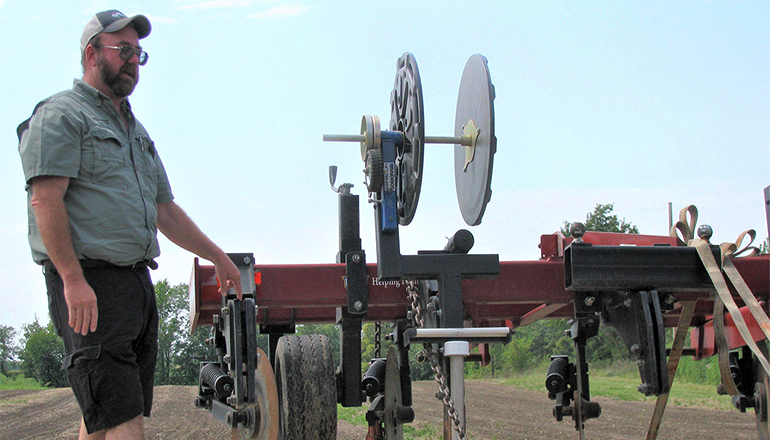Research from the University of Missouri Extension finds that subsurface irrigation as part of an integrated drainage water management system boosts corn yields by more than 40 bushels per acre and up to 14 bushels per acre for soybean on poorly drained flat soils. Further research is evaluating sub surface drip irrigation on soils with greater slopes.
MU Extension agronomist Rusty Lee showed the profit-boosting results at a recent field day at his Truxton farm. Lee’s work is part of a subsurface drip irrigation study on soybean and corn conducted by MU agronomist Kelly Nelson, a graduate researcher Rafid Al Ubori and nutrient management specialist John Lory.
Lee uses drip irrigation to manage water on no-till test plots rotated in corn and soybean. Water is the only variable in the tests. Researchers show consistent yield gain through uniform water and nutrient supply. They compare results to non-irrigated plots and those with overhead irrigation.
Researchers study sub surface irrigation at varying depths to find what works best. For the study, Lee trenched 5/8-inch diameter plastic tubing called drip tape. He used a modified conservation ripper to bury the tape and connecting PVC pipe. The pipe feeds water to the tape via a pressure manifold and flush manifold. Sensors transmit readings to a wireless data collection system, which uploads the data to a website for monitoring. Water exits the drip tape from emitters spaced every 2 feet along its length.
Researchers bury the tape 12, 14 and 16 inches deep for testing. Lee is comparing 12- and 16-inch placement in Warren County’s claypan soils. Water comes from an irrigation well and passes through a disk filtration system.
Researchers use MU’s free Crop Water Use web app (cropwater.org) to schedule crop irrigation. Data is automatically added from MU Extension weather stations and the National Weather Service.
Lee says irrigated land produced 41 more bushels of corn per acre last year. With corn prices estimated at $3.50 per bushel, that is about $158 more per acre for the farmer. Kernel size increases and test weight improves with irrigation. Root systems of plants also reach deeper.
Lee estimates it costs about $30.75 per acre for this year’s well pump energy costs, and there’s a one-time system installation expense of about $700 per acre. The cost is similar to pivot systems, but drip irrigation gives farmers with small fields more flexibility. Drip irrigation reaches small and irregularly shaped fields, corners of all fields, and sloping ground, says Nelson.
Drip irrigation works differently for corn and soybean, Lee says. Soybean needs less water earlier in the season compared to corn, and it surpasses corn needs later in the season. Too much water early in the season stunts beans.
Drip irrigation prevents wetting of leaves and results in fewer foliar diseases. Farmers can zone drip irrigation to specific areas of a field. It does not require large pumps and wells, and it uses less energy than pivot irrigation. Water usage can be reduced by 25 percent. Crops respond well to nitrogen fertilizer applied through drip irrigation, Nelson says.
Nelson says subirrigation research shows gross margins improved greatly for corn. His decade-long study shows that subsurface drainage and integrated water management systems increased yields 9 to 14 bushels per acre and corn yields 25 to 55 bushel per acre on flat, poorly drained soils.
However, drip irrigation has its drawbacks, Lee says. The system has to last more than 10 years to recoup initial installation costs. Lee’s research shows that most do. Rodents can chew through drip lines, but Lee says it takes about five minutes to make repairs after finding the source of the leak.
Water filtration systems need frequent monitoring. Particulates and bacterial growth require periodic system flushing to prevent clogging.
“Establishment of long-term research to evaluate subsurface drip irrigation will help farmers make informed decisions on the cost-effectiveness of drip irrigation systems on claypan soils where inadequate water has significantly limited yield in four of the past 10 years,” Nelson wrote in 2013.
“Water management will continue to be one of the major factors affecting crop production in Missouri,” Nelson says. Good surface drainage and the ability to provide a controlled water supply in times of need will provide food production stability and should increase profitability.
The USDA Natural Resources Conservation Service offers financial assistance for irrigation systems. See goo.gl/MPfuHV.
The Missouri Soybean Merchandising Council financially supported the project. The Higher Committee for Education Development in Iraq provided funds for a graduate student to assist in the project.
For more information about the Crop Water Use app, go to cropwater.org. A guide to the application is available as a PDF download at extension.missouri.edu/p/MP800.







